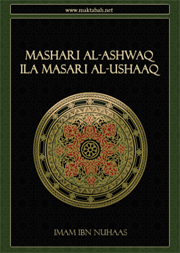Mashari Al-Ashwaq ila Masari al-Ushaaq
مشارع الأشواق إلي مصارع العشاق - في فضل الجهاد في سبيل الله

About the author
The author’s full name was Ahmad Ibrahim Muhammad al-Dimashqi al-Dumyati, commonly known as Ibn an-Nuhaas and he died in the Year 814 Hijri, corresponding to the Year 1411 of the Gregorian calendar.
Al-Sakhawi said about him:
“He was eager to do good, preferred living in obscurity and showed no arrogance or pride due to his knowledge. Whoever would see him would think that he was a commoner – a handsome man, with a beautiful beard, short and medium built. He spent most of his life stationed in Jihad until he died as a martyr.”
Ibn al-Imad said about him:
“The Sheikh, Imam, scholar and exemplar.”
In 814 Hijri the Romans attacked the people of Teenah in Egypt. The people of Dumyat, led by Ibn an-Nuhaas went to join their brothers in their fight against the invading forces. Ibn an-Nuhaas was killed in the battle, whilst facing the enemy and not fleeing from them, nine months after he completed writing this book.
About the book
=================
Sheikh Abdullah Azzam said about this book: “This is the best book on Jihad.”
It is considered the most comprehensive study on the subject of Jihad because it was written by an author who practised, lived and experienced what he preached.
Syed Qutb said: “Indeed our words will remain lifeless, until we die in pursuit of those words, then those same words will be brought to life and live amongst the people, inspiring them and bringing their hearts to life.”
HTML clipboardPDF Book in: English or/and Arabic
English AUDIO:
01 - Jihad in Islam, Its meaning
02 - The Command of Jihad and its Mandate Warning
03 - Advise to the Ones who stay behind
04 - The Virtues of encouraging Jihad
05 - Contin Section of Ribaat
06 - The Virtues of Injury in the Sake of Allah
07 - Dueling
08 - The Intentions in Jihad
09 - The Virtues of Martyrs
10 - The Battles of the Messenger of Allah
11 - Operations of the Sahabah, Conclusion

